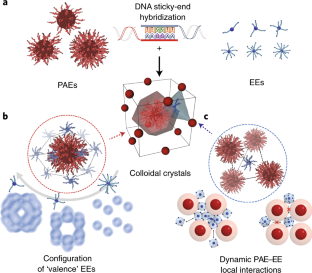電子の等価性を利用した新しい手法で、対称性の低いコロイド結晶を合成するためのルールを作成 New method uses electron equivalents to create rules for synthesizing low-symmetry colloidal crystal
2022-01-13 ノースウェスタン大学
・ノースウェスタン大学とミシガン大学の研究により、対称性の低いコロイド結晶を合成する方法が初めて明らかにされた。
- https://www.mccormick.northwestern.edu/news/articles/2022/01/how-to-break-symmetry-in-colloidal-crystals/
- https://www.nature.com/articles/s41563-021-01170-5
電子等価物を介したコロイド結晶の価数の出現 The emergence of valency in colloidal crystals through electron equivalents
Shunzhi Wang,Sangmin Lee,Jingshan S. Du,Benjamin E. Partridge,Ho Fung Cheng,Wenjie Zhou,Vinayak P. Dravid,Byeongdu LeeSharon C. Glotzer &Chad A. Mirkin
Nature Materials Published: 13 January 2022

Abstract
Colloidal crystal engineering of complex, low-symmetry architectures is challenging when isotropic building blocks are assembled. Here we describe an approach to generating such structures based upon programmable atom equivalents (nanoparticles functionalized with many DNA strands) and mobile electron equivalents (small particles functionalized with a low number of DNA strands complementary to the programmable atom equivalents). Under appropriate conditions, the spatial distribution of the electron equivalents breaks the symmetry of isotropic programmable atom equivalents, akin to the anisotropic distribution of valence electrons or coordination sites around a metal atom, leading to a set of well-defined coordination geometries and access to three new low-symmetry crystalline phases. All three phases represent the first examples of colloidal crystals, with two of them having elemental analogues (body-centred tetragonal and high-pressure gallium), while the third (triple double-gyroid structure) has no known natural equivalent. This approach enables the creation of complex, low-symmetry colloidal crystals that might find use in various technologies.



